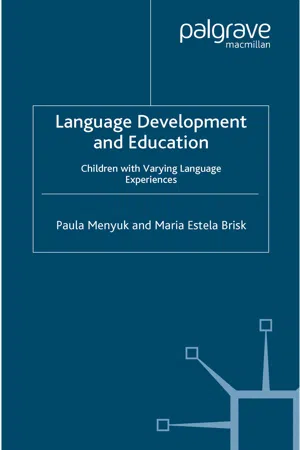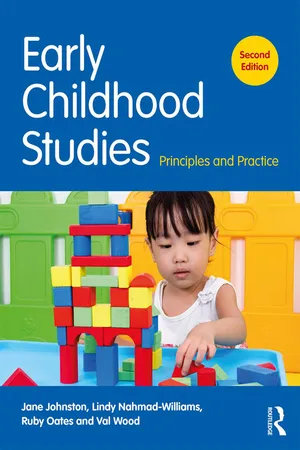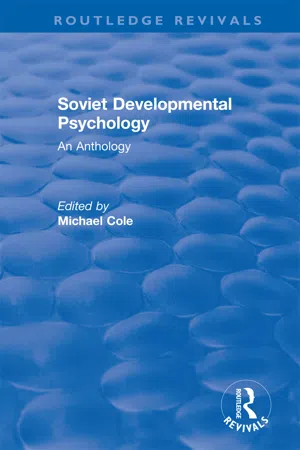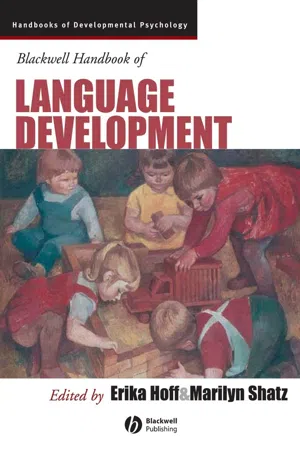Languages & Linguistics
Babbling
Babbling refers to the early stage of language development in infants, characterized by the production of repetitive syllables such as "ba-ba" or "da-da." This prelinguistic vocalization is a natural part of language acquisition and serves as a precursor to the development of meaningful speech. Babbling allows infants to practice and refine their articulatory skills in preparation for producing words and sentences.
Written by Perlego with AI-assistance
Related key terms
1 of 5
11 Key excerpts on "Babbling"
- eBook - PDF
- Neil J. Salkind(Author)
- 2005(Publication Date)
- SAGE Publications, Inc(Publisher)
Babbling Babbling is the stage of language development dur-ing which children produce speech sounds arranged in nonsensical combinations, such as “bababa,” “deedeedee,” or “badegubu.” All normally developing children bab-ble. Parents and family members may view Babbling as an endearing but trivial behavior produced by infants; however, Babbling represents a stage of language devel-opment during which the child is laying the foundation for future adult-like language production. THE SOUNDS OF Babbling The first vocalizations produced by infants include crying, laughing, and cooing. When infants are between 2 and 3 months old, they begin to coo. Cooing infants produce sounds that most closely resemble the vowels a, e, and o. Cooing may be an extended single vowel as in “oooo” or “aaaa” or a complex series of vowels, “aaaeeeooo . ” Babbling typically begins by the 6th month. Table 1 provides a summary of the types of utterances produced by the child in the first year. Between the 6th and 7th months, infants gain greater control of jaw movements, enabling them to produce the vowels i and u and the consonants g and k. Over time, infants begin producing the consonants m, n, p, b, and d. During this time, infants engage in vocal play. They may produce nonspeech sounds such as squealing, yelling, and growling. They may also produce raspberries , which are created when the tongue is extended through rounded lips and air is forced through the mouth. Between 6 and 9 months, infants begin to combine a single consonant and vowel together in a long repetitive sequence, such as “bababababa” or “deedeedeedee.” Such sequences are characteristic of canonical Babbling . Over time, infants’ Babbling becomes more complex. Productions typically involve different syllables produced in the same utterance, as in “badegubu” or “deekidobu . ” Such sequences are characteristic of variegated Babbling. - eBook - PDF
Language Development and Education
Children With Varying Language Experiences
- P. Menyuk, M. Brisk(Authors)
- 2005(Publication Date)
- Palgrave Macmillan(Publisher)
To begin with the infant produces various kinds of vocalizations (crying, cooing, raspberries, etc.) and then begins to babble. The composition of this Babbling appears to be universal until the age of around 12 months when there is some indication of understanding the meaning of some words. Babbling then becomes more representative of the speech sounds of an infant’s own language or languages. The repetitive bab- bling the baby produces requires the ability to move the articulators in a more complex manner than do vocalizations like cooing and rasp- berries. Babbling occurs when the baby has greater control of the artic- ulators. Bilingual infants babble with sounds in their two languages. The order in mastery of production of speech sounds seems to continue to be dictated by ease of articulation as well as perceptual 10 Language Development and Education distinctions between sounds. It is easier to say mama and baby (con- sonant vowel syllable) than put (consonant, vowel, consonant syllable). It is easier to say batu than bottle, to say fis than fish, and so on. Speech production begins as a universal process and then sharpens to a par- ticular set of speech sound productions and combinations. However, in this developmental shift, ease of articulation continues to play a role. Bilinguals develop two sound systems without confusing them. However, when a sound is easier in one language than the other, it is produced first and then used in both languages. For example, Latvian uses apical /r/, while in southern Swedish it is a uvular /r/. This latter sound is more difficult to produce. When a child is learning both lan- guages the apical /r/ is used in all contexts that require an /r/. A further example is from Burling (1959). He reports that his son had differenti- ated vowels for English and Garo, but used Garo consonants until he was 3–4 years when the family moved to the U.S. - eBook - PDF
Educational Psychology N5 SB
TVET FIRST
- M Adam(Author)
- 2017(Publication Date)
- Macmillan(Publisher)
• Indicates the beginning of single-vowel production, such as “ah-ah” or “ooh-ooh”. • Is a vital part of learning to speak. Babbling (6–10 months) Babbling is the stage in language acquisition during which the baby appears to be experimenting with articulating sounds, but cannot produce recognisable words yet. When babies babble, they repeat consonant or vowel sounds – for example, “da-da-da-da-da” or “ma-ma-ma-ma-ma”. Figure 2.10: Babies learn that their own behaviour can have a powerful effect on the behaviour of others Did you know? Experts have found that exposing babies to clear vocal sounds from birth helps them to distinguish language from other sounds. Babies soon learn that their own behaviour, such as their smiles and the sounds they make, has a powerful effect on the behaviour of others, such as their parents or caregivers. 64 Figure 2.11 shows the different types of Babbling. Types of Babbling Expressive Babbling: Sounds that resemble sentences and have the same pauses and rhythms of normal speech, but are not yet communicative; used in the second year of life as a means of communication Reduplicated Babbling: Repeated syllables consisting of a consonant and a vowel (e.g. “da-da-da-da” or “ma-ma-ma-ma”) Marginal Babbling: The baby combines consonant–vowel or vowel–consonant sounds (e.g. “baaaa”, “maaa”, “uuum”) Variegated or non-reduplicated Babbling: A mix of syllables (e.g. “ka-da-bu-ba-mi-doy-doy-doy”) Figure 2.11: The types of Babbling You can encourage Babbling by: • Giving the baby a toy and talking about it. • Making eye contact with the baby while having a conversation. • Imitating the baby’s babbles. • Repeating the sounds that you hear him or her imitating. • Asking a lot of questions. • Telling the baby what you are doing. • Saying, “What’s that noise?” and pointing out the source of the sound to the baby. - eBook - PDF
Child Psychology
A Canadian Perspective
- Alastair Younger, Scott A. Adler, Ross Vasta(Authors)
- 2014(Publication Date)
- Wiley(Publisher)
For example, babies add changing intonation to their sounds so that their Babbling includes the same patterns of rising and falling pitch that we might hear in adult speech (Clumeck, 1980). In addition, many of the sounds that infants produce late in the Babbling period are sounds that they will display when they first begin to produce words (Oller, 2000). Babbling is so similar among infants of different language groups that biological mechanisms undoubtedly play a major role. But when infants finally begin to speak, they say only words from the language they have been hearing. Does this mean that speech emerges separately from Babbling? Or, instead, does the form of Babbling steadily gravitate toward the language the child hears—a theoretical notion called Babbling drift (Brown, 1958b)? Evidence has been reported on both sides of this issue, but it seems to be accumulating in favour of the drift hypothesis (Blake, 2000; Boysson-Bardies, 1999; Locke, 1993). For example, at the end of the first year of life, French-learning infants produce conso- nants that include sound cues specific to French much more than do English-learning infants of the same age (Whalen, Levitt, & Goldstein, 2007). In a study conducted at McGill University, researchers demonstrated that English-learning infants produced different vowels than French-learning infants (Rvachew et al., 2008). In either case, this issue nicely illustrates the difference between the continuity and discontinuity views of children’s preverbal abilities. The possible role of environmental factors in Babbling has also led researchers to examine the vocalizations of deaf infants. If babies do not hear speech, will they still display Babbling? The answer is yes, but the nature and course of Babbling are not identical to the typical pattern for Cooing A stage in the preverbal period, beginning at about 2 months, when babies primarily produce one- syllable vowel sounds. - eBook - PDF
Early Childhood Studies
Principles and Practice
- Jane Johnston, Lindy Nahmad-Williams, Ruby Oates, Val Wood(Authors)
- 2018(Publication Date)
- Routledge(Publisher)
By the end of the first year most children are capable of producing all the vowel sounds and nearly half the consonants (Doherty and Hughes, 2014: 307). This tends to consist of repeated syllables, such as ‘dadada’, increasing in consistency up until 10 to 12 months of age, often overlapping slightly with the child’s first words. At about 9 months, the Babbling is consistent with the phonology of the child’s first language, so there is a notable difference between the Babbling of a baby exposed to English and that of a baby exposed to another phonology, such as Urdu (Mukherji and O’Dea, 2000). Babies spend a lot of time watching and listening. They see the lips moving as an adult talks to them and hear the pat- tern and rhythm of their voices. There is also evidence that babies can hear when they are still in the womb. Recordings within the uterus have demonstrated that sounds like voices, in particular the mother’s voice because it is transmitted externally and internally through bones and body tissues, can to some extent be heard in the uterus (Smith et al., 2012: 397). Babbling is present in both hearing and deaf babies, which raises questions about whether or not it is a stage of language development, as it is not a direct response to the sounds heard by the baby. Deaf babies’ Babbling does eventually cease at about 9 months (Herman, 2002), which also coincides with the stage at which the Babbling takes on the phonology of the language the baby is hearing. We could conclude from this that Babbling becomes the first stage of speech development at approximately 9 months, or when the phonology becomes distinct. Part 2 Early Years Development 182 The following definitions of ‘synthetic’ and ‘analytic’ phonics have been taken from Greg Brooks’s report Sound Sense: The Phonics Element of the National Literacy Strategy – A Report to the Department for Education and Skills , University of Sheffield (2003). - Maurice Merleau-Ponty, Hugh J. Silverman(Authors)
- 1979(Publication Date)
- Northwestern University Press(Publisher)
1 / The Psychological Development of Language in the 'Child [1] AN OVERVIEW DURING THE FIRST MONTHS OF LIFE, the child cries; he makes expressive movements; and then he begins to babble. One must consider this Babbling as the ancestor of language: it is, above all, extraordinarily rich and includes phonemes which do not exist in the language that is spoken around the child, and which he himself, once he has become an adult, is incapable of reproducing (for example, when he wants to reacquire t'hem to learn a foreign language). This Babbling is therefore a poly- morphic language, whieh is spontaneous with respect to its en- vironment. (It exists in deaf-mute children, even though it is not as well developed.) There is, however, a large amount of imita- tion. This imitation reaches its culmination between six and twelve months, but it remains rudimentary to the extent that the child does not grasp' the meaning of that which he is imitating. The same relationship' exists between Babbling and language as between scribblin,g and drawing. This imitation concerns the melody of the sentence just as much as the words, because the child tries, as it were, to speak "in general." W. Stem relates that, for a month, his daughter spoke a foreign ''language,'' which had 'a conversational tone but which did not mean anything. 1 (It was as though she were playing I. [See William Stern, Psychology of Early Childhood (New York: Holt, 1931).] [II] 12 / CONSCIOUSNESS AND LANGUAGE ACQUISITION at speaking.) According to Delacroix, "The child bathes in language." 2 He is attracted and enthralled by the movement of dialogue around him, and tries it himself. Language is the indissoluble extension of all physical activity, and at the same time it is quite new in relation to that physical actiVity. Speech emerges from the "total language" as constituted by gestures, mimicries, etc.- Michael Cole(Author)
- 2017(Publication Date)
- Routledge(Publisher)
Although Babbling does feature certain differences from cooing — differences that, in our opinion, have been correctly charac terized by A. A. Leont'ev (11) — these two prespeech stages are in reality so intertwined during the transition from one to the other that the boundary between them is scarcely distin guishable. Indeed, the same sort of indistinct boundaries may be observed in the transition from Babbling to actual speech: for a certain period the child may already be uttering discrete words and interspersing segments of Babbling that have no con nection with objects or phenomena in the environment. More over, the boundary between cooing and Babbling, like the one between Babbling and speech, is subject to individual variation, and may be delayed or accelerated in different children. Our own observations indicate that the Babbling stage begins somewhere between the fourth and fifth months. A. A. Leont'ev mentions about the same age (11). As we analyzed our research material, the main question that arose for us was: How is Babbling related to the linguistic en vironment in which the child is situated at that particular time ? Or, in other words: Does Babbling develop under the influence of the immediate linguistic environment or not ? This is not an idle question, since the answer is by no means clear in the lit erature on the subject. Some authors, including V. A. Bogoro ditskiy (5), regard Babbling as the child's amusing himself ' with the actual processes of sound production; he is engaging in a unique type of play, similar to that expressed in random arm and leg movements, for example. Other authors, such as I. A. Sikorskiy (16) and A. Aleksandrov (1), consider Babbling a prod uct of the infant's imitation of the speech of the people around him. One way to resolve this question is to compare the phonetic com position of Babbling with the system of speech sounds (phonemes) of the language spoken by the people in the child's environment.- Margaret K. Omar(Author)
- 2017(Publication Date)
- De Gruyter Mouton(Publisher)
6 The first evidence of recognition and understanding of certain symbolic gestures, intonations and words comes in the latter part of the Babbling stage, 1 Lewis, cited in Weir, 1966: 157. 2 Carroll, 1961; 333. 3 Fry, 1966, 192. 4 McCarthy, 1954, 503. 5 Morris M. Lewis, Infant Speech: A Study of the Beginnings of Language (New York, Humanities Press, 1951) pp. 115-116, 122. 6 Carroll, 1961, 333. EARLY COMMUNICATION AND INITIAL VOCABULARY 75 at about 8 to 10 months. At this point the brain has matured to the level of development which has been called speech readiness.' By 10 to 12 months, the normal child can differentiate some words and understand simple commands, and by 18 months, demands and prohibitions. 8 Usually a child canun derstand more than he can say. It is possible to learn to understand a language without learning to speak it, and this situation can be present for a time in normal primary language acquisition. Carroll states that the over-all frequency with which items occur in speech heard by the child has an important relation to the developmental sequences in which items are learned, although it is possible that the frequencies heard by the child do not correspond to those in adult speech. 9 When the early speaking stage begins, it still overlaps with Babbling for some months. A word may be used by the child to cover a wide variety of meanings. For example, Leopold observed that mama was articulated by his child in the first year, but did not take on the referential meaning of 'mother' until 16 months. Similarly, papa, articulated at 7.5 months, took on referential meaning at 13 months. 10 Lewis states that mama is an early discomfort sound, and is later used in asking for something, and linked with food and sleep, as well as with the mother.- eBook - PDF
- Gert Rickheit, Hans Strohner, Gert Rickheit, Hans Strohner(Authors)
- 2008(Publication Date)
- De Gruyter Mouton(Publisher)
This is often referred to as variegated Babbling. The prosodic patterns during this stage match the native language, often leading parents to comment that the child has her own language. By 12 months of age, the infant’s speech production system has taken on many characteristics of the target language. The majority of sounds produced are clearly recognized as belonging to the native language, setting the stage for pro-duction of first words which tend to emerge around 10 to 14 months. Productive phonology appears to influence production of first words. Typically developing children learn words composed of sounds that are observed in their Babbling (Ferguson and Farwell 1975; Oller, Wieman, Doyle, and Ross 1976; Stoel-Gam-mon and Cooper 1984; Velleman and Vihman 2002; Vihman, Ferguson, and El-bert 1986; Vihman, Macken, Miller, Simmons, and Miller 1985). These studies have typically focused on naturalistic collection of speech samples with subse-quent analysis and comparison of phonology in babble and phonological charac-teristics of the words attempted and/or learned. For example, Stoel-Gammon and Cooper (1984) examined the consonantal phones used in Babbling and compared this to the consonantal phones used in first words by three children who were ap-proximately one year of age at the beginning of the study. Over half the phones observed in Babbling were produced in first words. About half of the phones that children babbled but did not produce in first words were non-English sounds that would not be targeted by English words. Likewise, Vihman and colleagues (1985) showed that the distribution of consonants and the syllable structure of first words were identical to that of babble. This finding suggests continuity be-tween Babbling and first words. - eBook - PDF
Child Psychology
Development in a Changing Society
- Robin Harwood, Scott A. Miller, Ross Vasta(Authors)
- 2012(Publication Date)
- Wiley(Publisher)
Crying serves as a means of communication to the parents or other caretakers. During the second month, infants begin cooing, using their tongues and extended vowel sounds to articulate. Coos appear to express feelings of pleasure or positive excitement. Infants tend not to coo when they are in discomfort. Between 6 and 9 months of age infants begin Babbling, the first vocalizing that sounds like human speech. All children appear to babble, even deaf children (Oller, 2000). In Babbling, infants typically combine consonants and vowels, such as ba and ga, and repeat sound combinations such as the highly reinforcing “mama” and “dada.” Despite similarities to real words, however, these first combinations are chance occurrences. Although crying, cooing, and Babbling are innate behaviors, they can be modified by experience (Volterra et al., 2004). Cooing increases when parents talk to the infant, smile at them, or coo in response to the child’s prelinguistic sounds. Modeling and imitation may also play a role in Babbling. At first, Babbling is the same around the world. Soon, however, the language spoken by parents and other adults begins to have an influence. Adults often repeat the syllables uttered by their infants and combine syllables instead of using single syllable utterances. For example, adults often say “dadada” instead of “da.” Repetition may aid the infant in discriminating these sounds from others and also may encourage the imitation of these sounds. Around 10 to 12 months, infants tend to demonstrate echolalia, the automatic repe- tition of sounds, syllables, or words. These repetitions often sound like the child is carry- ing on a one-sided conversation. Then around 11 to 13 months many children speak their first word, an important milestone for parents. A range of approximately 8 to 18 months is considered normal (Bates, Thal, & Janowsky, 1992). - eBook - PDF
- Erika Hoff, Marilyn Shatz, Erika Hoff, Marilyn Shatz(Authors)
- 2008(Publication Date)
- Wiley-Blackwell(Publisher)
These studies do not, however, illuminate the exact nature of experiential influences on the course of prelinguistic vocal develop-ment. Oller (2000) suggests that a certain amount of auditory experience is required for “triggering the events that lead to well-formed syllable production” (p. 132). It is not clear that the specific phonetic content of the adult input is important to the process and indeed, no direct link between underlying perceptual representations and the character-istics of infant speech has been established. The dominant view posits that Babbling is a strongly canalized motor behavior in which feedback of self-produced sounds serves to help the infant coordinate articulation and phonation (Koopmans-van Beinum, Clement, & van den Dikkenberg-Pot, 2001) or regulate the temporal rhythm of babble, in a manner similar to the way in which audible rattles seem to facilitate rhythmic hand-banging (Ejiri & Masataka, 2001). By contrast, the DIVA model emphasizes the role of speech input in the formation of auditory–perceptual targets for speech output as well as the importance of auditory feed-back of the infant’s own speech for the achievement of speech motor control. This model predicts that the speech environment will influence the acoustic-phonetic characteristics of the infant’s speech output from at least the beginning of the canonical Babbling stage. Investigations of this hypothesis sometimes employ laboratory induced variations in speech input to the infant but more frequently examine the impact of natural variations in the auditory environment associated with different language groups. Laboratory investigations of the impact of speech input on speech production.
Index pages curate the most relevant extracts from our library of academic textbooks. They’ve been created using an in-house natural language model (NLM), each adding context and meaning to key research topics.










